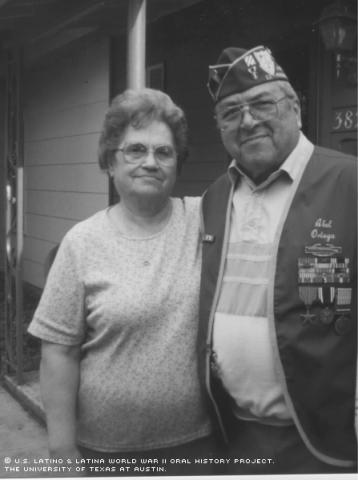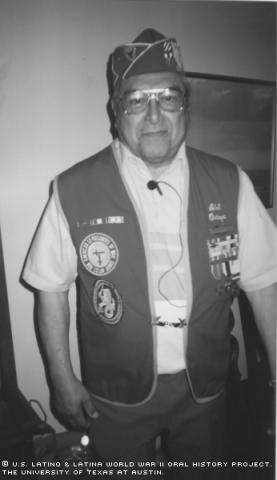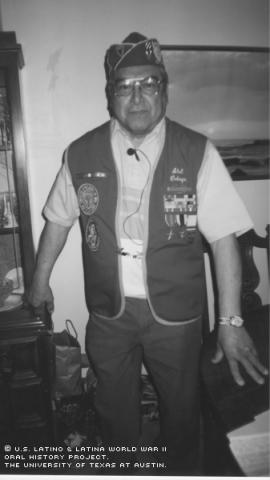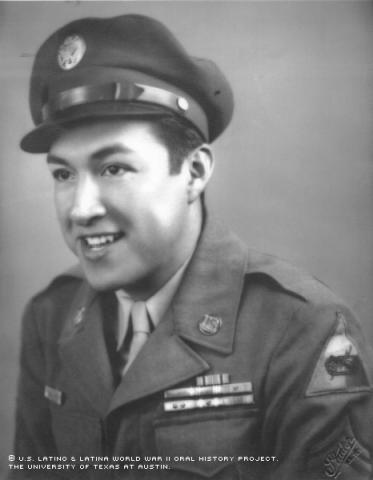



By Joanne R. Sánchez
When Abel Ortega was growing up, his family used to call him "the big thinker." "I was thinking of ways to reach the Far East," he said.
He had seen magazine pictures of the Chinese and the Japanese. Later, he sat in a rocking chair and pondered travel to those far away, seemingly unreachable destinations.
"My father was not a rich man, so I did not expect to ever go and visit these countries," he said.
He didn't realize then that his dream of going to the Far East would materialize, and that his experiences in that region of the world -- as part of the Bataan Death March, as a Japanese prisoner of war -- would be far different from what he’d imagined.
Ortega's parents, Ruben Cantero Ortega and Deborah Flores Ortega, fled the violence of the Mexican Revolution to El Paso from Chihuahua, Mexico, a few months before his birth. The couple had six sons and two daughters, as well as adopted two children, a boy and a girl. Soon after Ortega was born, the family moved to Austin, Texas. His father, who was college-educated, taught tuberculosis prevention to Mexican-American communities across the state with the Texas Tuberculosis Association; he also served as a minister-at-large at various churches in Austin.
Ortega enjoyed drawing and was the art editor for the Austin High School 1939 yearbook. After graduation, he worked as a commercial artist for Modern Signs.
Speaking from his San Antonio home, where he and his wife, Naomi Rodriguez Ortega, had lived for more than four decades, Ortega painted a vivid picture of his past.
In March 1941, he was drafted into the Army. He completed his basic training in Fort Knox, Ky., and was sent to Camp Polk, La. It was there that his opportunity to reach the Far East came.
"They brought the whole battalion to the field, and we were all lined up. And they asked for volunteers to go to the Far East, to the Philippine Islands," he said.
Ortega continued: "I saw this as my opportunity, so I was one of the first to step forward immediately as a volunteer to go to the Philippine Islands."
He joined the 192nd Tank Battalion, Company A, and arrived in Manila on Thanksgiving Day 1941, two weeks before Pearl Harbor.
After unloading the ships all day on the holiday, Ortega looked up a friend, Joel Ruiz, who was stationed at Fort Stotsenberg, near Luzon, Philippines. Joel gave Ortega "a piece of bread with a little gravy on it."
That was his Thanksgiving meal.
News about the bombing of Pearl Harbor reached them on December 8.
"That really shook us up," he said.
"So our officers lined us up and told us to go and disperse all of our tanks [and] half-tracks [,armored personnel carriers with tracks on the back,] into the jungles around Clark Air Force Base [,next to Fort Stotsenberg in Luzon,] to camouflage them," he said. "They put me and another fellow from Oklahoma to guard all these tanks and half-tracks out there in the jungle while everybody else went to eat [lunch]," he recalled.
On December 8, while he was in the jungle guarding this equipment with fellow battalion members, he said they began to hear a humming noise grow louder and louder. They could see bombers approaching the base.
"As they were coming over, we heard hissing sounds," he said.
They wrongfully assumed the thousands of planes were U.S. forces coming to prepare for a counter-attack against the Japanese.
"To our surprise, these airplanes were not American airplanes," he said, recalling that a friend looked through some binoculars and saw the Japanese insignia.
"As the bombs fell, the shrapnel would come through the jungle and ... cut down the trees," he said. "[There was the] devastation of bombs bursting all around Clark Air Force Base. Black smoke was billowing all over the airfield; planes were being shot on the ground, fires were everywhere."
Following the bombers, came Japanese fighter planes. Ortega got his 50-caliber machine gun from his half-track and began to fire.
"I assumed it was my responsibility to do what I could with what I had," he explained.
"I couldn't tell if I had hit them, there was so much smoke.”
His commanding officer didn’t order other men to go out to shoot at the fighter planes.
"It was complete chaos," he said.
Ortega was one of few who were able to fire back with an effective enough weapon to reach the bombers.
After the officers sent all the tanks north, Ortega was left behind on his half-track to help guard the base. Japanese bombings continued daily. Since he didn’t have any food, he went to the Post Exchange, which he found abandoned.
"Everybody had scattered due to the bombings," he said. "There was nobody there."
They got all the supplies they could load onto the half-track and met the rest of his tank unit further north.
The Japanese landed on December 22 at Lingayen Gulf, 150 miles north of Manila, and the Americans were forced to retreat. With around 15,000 American military personnel compared to about 150,000 Japanese troops, the U.S. forces were "overwhelmed," Ortega said.
Conditions were bleak on Bataan Peninsula, where the Americans had retreated. They had no supplies and had to rob their own Army trucks to get food, Ortega said.
"We ate all of the horses of the cavalry . . . all of the water buffalo . . . all of the monkeys, and all the snakes, and everything else that moved in order to stay alive," he said. "It was a horrible ordeal."
The Japanese not only confiscated the Americans' food, they took medical supplies; the American soldiers began to succumb to malaria, dysentery and other tropical diseases, as well as to combat fatigue.
Ortega remembered the troops were also hampered by outdated, World War I ammunition.
"Some of that didn't even fire," he said.
Despite the monumental difficulties, the American troops -- and the Filipino allies -- on Bataan were able to fight off the Japanese landings until April of 1942.
"We were overwhelmed," he said. "There were just too many . . . Japanese."
According to historical accounts, about 12,000 American troops were there, leading 66,000 poorly trained and equipped Filipino soldiers. Most of the American air power in the Philippines had been destroyed at Clark Field by the Japanese months before. While General MacArthur believed there were 80,000 Japanese troops bolstered by 100,000 replacements, the actual number of Japanese was probably around one-third of his estimate.
Finally, after about four months, it became clear that an American surrender was inevitable; the soldiers were ordered to destroy their equipment so it would not fall into enemy hands.
The 22-year-old Ortega knelt down next to his half-track and prayed, "Oh God. I don't want to die."
He asked that if he were to live that God would give him "fortitude to help [his] fellow man." He then cried and cried; afterward, he said he was prepared for whatever might come his way.
Most of the troops met at Mariveles, where they waited for the Japanese to take them. Instead, they encountered chaos, he said.
"We didn't know what to expect," he said. "We received no orders from anybody."
Shortly afterward, they met the Japanese soldiers, which Ortega called, "One of the most heart-shaking experiences ... they were brutal … they had no respect for life ... they would harass you ... they would strip you down.
"You had no control other than your faith in God," he said. "That's one thing that they could never, never take away from you."
Ortega described the brutality that the men endured during what became known as the Bataan Death March.
"I [saw] heads cut off by Japanese and saw my fellow men, who could not keep up with the marches, shot just because they got out of line," he said. "You couldn't urinate or do anything out of line."
They marched them in groups of 100, four men to a row, from Mariveles to the town of San Fernando, about 60 miles away.
The Americans and Filipino prisoners of war weren’t given anything to eat or drink, and many of the men died along the way. In a heat that reached more than 100 degrees, the prisoners had to step out of line to get water or food, if they saw crops growing. But by stepping out of line, they risked being shot.
"You had to take chances like that," he said. "If you were thirsty and saw an open well ... you would run to satisfy your thirst because you were marching in the hot blistering sun."
Ortega detailed some of the atrocities he witnessed. On one occasion, he saw a Filipino attempting to cook some rice, and "A Japanese came and drove his bayonet right through his back," Ortega said.
On other occasions, some Americans were weak and fell to the ground.
"The Japanese would put them up against a post, and practice their bayonet on them," he said. "In the Japanese code, you were not supposed to fall down."
A number of days after arriving in San Fernando, the prisoners were loaded tightly into railroad box cars to go to Camp O'Donnell (about 20 miles north of Fort Stotsenberg).
"Bodies were so tight, that some died," he said. "They were just thrown out."
Ortega said that at Camp O'Donnell there were so many prisoners most slept on the ground. They had no food and fights broke out over water. With no sanitary facilities, a stench permeated the camp. Because "hundreds died every day," he was put on burial detail.
"There wasn't a grave at all," he said. "We just shoved wet mud over them. ... The people on the burial detail were just as weak, and some of them were buried in the same way."
From Camp O'Donnell the Americans (the Filipino prisoners stayed behind) were sent to Camp Cabanatuan. Located 100 miles north of Manila, it was the main camp. Ortega said conditions at Cabanatuan were even worse -- no sanitary facilities, and increasing numbers of sick, weak and mentally deranged men. In the middle of the inhumane conditions, it became each man for himself.
"When somebody died next to you, you [were] glad because it gave you more room," he said. "You weren't thinking, 'I'm sorry he died.' You were trying to survive."
Since there were no meals served at the camp, the prisoners had to forage for food when they were on work details. They picked berries and plants, and would find out what was edible through trial and error.
"Somebody either died or got sick testing out plants," Ortega explained.
In addition to the privations of the camps, the men were also subjected to torture, or "punishment," as Ortega put it. In one incident at Camp Murphy, another camp where he was sent, he and two others were late for roll call. So in response, a Japanese soldier got his bayonet and hit Ortega on the side. The other man fell down.
The Japanese soldiers took all three men, placed a large tree branch behind their knees and ordered the men to kneel down. The Japanese jumped on the Americans' thighs throughout the night.
In September of 1944, when the Americans were approaching the Philippines, the prisoners were sent to Japan. As Ortega boarded the ship, he looked down and saw an empty can.
"A voice inside of me said to pick it up," he said.
On the ship, the Japanese put down an 18-foot ladder and "just shoved humanity down this ship," he said. "It was so crowded."
Down below, the temperature climbed slightly above 100 degrees, he said. Because he was under a wind funnel that dripped water, he was able to collect water in the can he picked up and trade sips of it for grains of rice.
"In those days, you would count grains, you wouldn't give a spoonful of rice," he said. "Rice ... was so precious down there."
During the 38-day journey, Ortega said about 38 people died. Many others went insane.
The conditions in Japan were significantly better for the prisoners. There was more rice, and they weren’t as crowded as they were in the Philippines. Since most of the men's uniforms had long worn out, the only thing many of the prisoners had to wear in the Philippines was a homemade g-string. Now, they received used Japanese uniforms.
One day, about a year later, the prisoners were surprised to see a man in khakis get off a train and tell them that the war had ended some days before. Soon, American B29 bombers began to drop food in 50-gallon drums by parachute over the camp.
Ortega, a graphic artist before the war, was asked by his warranty officer to make flags representing all of the nationalities of the prisoners in the camp: Australians, British, Dutch, Americans and one Japanese, so that the newly freed prisoners could have a flag-raising ceremony. Ortega used the nylon from the American food parachutes for the flags.
"I was the Betsy Ross of our American Prisoners of War," he said.
Some soldiers went to a nearby town to get instruments. They had a flag-raising ceremony, and the band played the national anthems of the former captives.
"It was a beautiful sight. I cried when the American flag was being raised," he said. "It was just a joy knowing that I was the one who made the flags. I cried because we were free. It was the most beautiful thing in the world to be free again."
Nearly two weeks later, the prisoners left for the U.S.
Ortega only weighed 98 lbs. at this point, having lost 38 lbs. in captivity. "What brought me through?" He asks. "Prayer. ... [and] faith in God."
His mother had six sons and a foster child who fought in the war. In the front window of the Ortega home was a flag with seven stars, signifying the number of children in the service. One of her sons, Daniel, was a medic in the Army and was killed in action in France -- making her a "Gold Star Mother."
As soon as the prisoners of war were released, they were allowed to make a three-minute call home.
"I said, 'Mother, this is Abel, your son.' There was a pause ... like she didn't recognize my voice, "he said.
Because of his captivity, Ortega didn’t know until after the war that all of his brothers had been overseas. His brother Samuel, or “Sambo,” was a sergeant in the 1st Cavalry Division in the European Theatre; Benjamin was a tech sergeant in the Army with the 36st Infantry Division in the European Theatre and Africa; Ruben, served as a quartermaster in the Navy in the Aleutian Islands; and Eliseo was a sergeant in the Air Force in the Pacific Theatre.
Ortega said the Christian faith of his parents, Ruben and Eufemia Ortega, helped them endure having all of their sons overseas.
"They trusted in God, and that helped so much. Of course ... they didn't know if I was alive or well," he said.
After the war, Ortega wanted to learn the dry cleaning business. The government paid for his training, and he went to work for Kelly Cleaners in Austin as a fur storage attendant, hatter and blocker.
On a car trip to Mexico City, he and his brother Ruben stopped in Dilley, Texas, at the home of Ezequiel Rodriguez, so Ortega could thank Rodriguez for sending him a letter when he was in the Philippines. In the letter, Rodriguez urged Ortega to rekindle his interest in his daughter, Amalia. At the Rodriguez home, he met Amalia's sister, Naomi, and the two began to correspond and date. They were married on Dec. 29, 1946.
Ortega remained in the Army reserves, so, in case he ever had to go back in the military, he would retain his rank of Corporal. In 1950, when he was 32 years old and had two children, he was called up for active duty in the Korean War. For some reason, "They took my rank away and made me a PFC," he said.
After all he’d been through, and because he was now married and had two children, he wasn’t anxious to return to a war front. Before leaving for Korea, Ortega "decided to turn my whole life over to Jesus Christ."
The decision would have repercussions; during his first battle in Korea, he questioned whether, as a Christian, he should kill. When he fired his rifle at the enemy and a blank discharged, he believed that God had answered him, so he vowed not to kill. He related a number of instances that occurred in Korea in which his faith gave him peace, so much so that he didn’t have bullets in his rifle during several engagements. Eventually, he was injured by a Napalm bomb dropped by American troops in Korea. He spent two months convalescing in Japan, and was then sent back into action.
In 1951, he returned home to his wife and children. Ortega was awarded more than 20 medals and citations for his valiant service in World War II and the Korean War, including the Purple Heart, a Bronze Star, a Silver Star, a Prisoner of War Medal, a Republic of the Philippines Presidential Unit Citation and a Republic of Korea Presidential Unit Citation, among others.
He and his wife raised seven children: Deborah, Daniel, Ruth, Susanna, Priscilla, Abel and Diane. Ortega acknowledges that his children's lives were very different from his.
"We did a lot of struggling," he said. "It helps you to become a better father."
Ortega keeps active. He volunteers his time as a chaplain for American Ex-Prisoners of War. He also speaks to groups about his war experiences.
Ortega's message for the younger generation: "Eternity is the most important thing," he said. "This life is short. ... It's a beautiful life knowing God. I am here today because of his grace and his mercy."
Mr. Ortega was interviewed in San Antonio, Texas, on March 29, 2001, by Joanne R. Sánchez.

